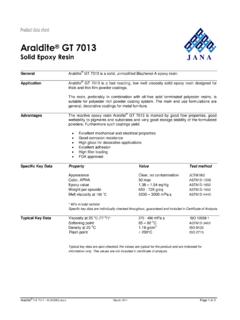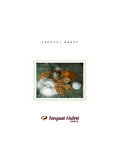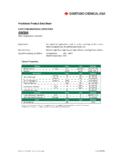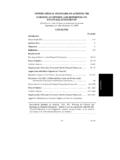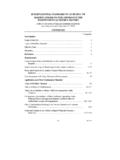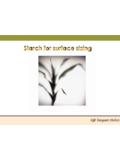Transcription of Adsorption isotherm studies of Cd (II), Pb (II) and …
1 Volume 32, n mero 1, 2007. Adsorption isotherm studies of Cd (II), Pb (II) and Zn (II). ions bioremediation from aqueous solution using unmodified and EDTA-modified maize cob Igwe1*, Abia2. 1. Department of Industrial Chemistry, Abia State University, 2000 Uturu, Abia State Nigeria. 2. Department of Pure and Industrial Chemistry, University of Port-Harcourt, River State. Nigeria. *Corresponding Author E-mail: Abstract: The need to clean-up heavy metal contaminated environment can not be over emphasized. This paper describes the Adsorption isotherm studies of Cd (II), Pb (II) and Zn (II) ions from aqueous solution using unmodified and EDTA-modified maize cob. Maize cob was found to be an excellent adsorbent for the removal of these metal ions. The amount of metal ions adsorbed increased as the ini- tial concentration increased. Also, EDTA - modification enhanced the Adsorption capacity of maize cob probably due to the chelating ability of EDTA.
2 Among the three Adsorption isotherm tested, Dubinin- Radushkevich gave the best fit with R2 value ranging from to and an average value of This is followed by Freundlich isotherm (Ave. ) and then the Langmuir isotherm (Ave. ). The sorption process was found to be a physiosorption process as seen from the apparent ener- gy of Adsorption which ranged from \mol to \mol. Therefore, this study demonstrates that maize cob which is an environmental pollutant could be used to adsorb heavy metals and achieve cleanliness thereby abating environmental nuisance caused by the maize cob. Keywords: Adsorption isotherm ; heavy metal; maize cob; waste water; EDTA. Introduction if they are essential metals [3]. Also, these metals in effluent may increase fertility of the sediment and The impact of heavy metal release into our water column and consequently lead to environment is increasing as a result of population euthrophicaiton, which in open waters can explosion, haphazard rapid urbanization, industrial progressively lead to oxygen deficiency, algal and technological expansion, increased energy bloom and death of aquatic life [3].
3 Utilization and waste generation from domestic and Water contaminated with metallic effluent industrial sources. These have rendered many can cause several health problems. Lead for waters unwholesome and hazardous to man and instance, can interfere with enzyme activities and other living resources [1]. The release of these formation of red blood cells. It can affect nerves heavy metals posses a significant threat to the and brain at low concentration. Heavy metals such environment and public health because of their as mercury, cadmium and chromium can bio- toxicity, bioaccumulation in the food chain and accumulate and through the food chain to toxic persistence in nature [2]. Metallic effluents can lead levels in man. Cadmium is responsible for kidney to increased nutrient load in water bodies especially tubular impairment and osteomalacia [3].
4 Ecl. Qu m., S o Paulo, 32(1): 33-42, 2007 33. Cadmium, zinc and manganese are reported to Langmuir and Dubinin-Radushkevich isotherms affect ion regulation if present in sufficient were used to analyze the experimental data. The concentrations [4]. Cadmium and manganese are effect of EDTA modification on the adsorbent also known to affect calcium metabolism, was also investigated. development and skeletal calcification as well as long term effect and spawning and recruitment of fish and other aquatic lives. Any changes in pH of Experimental details water bodies as a result of influx of effluent can cause serious change in water chemistry which can Material affect resources especially around the coastal areas. Maize (zea mays) cob was collected from The menace of these heavy metals has a local farm in Uturu, Abia state, Nigeria. They resulted in their urgent and effective removal.
5 A were cut into small pieces, air-dried and pow- number of technologies have been developed over dered in a grinder. The meal obtained was air- the years to remove heavy metals from industrial dried and first sieved through a 1000 m mesh wastewater, which include coagulation/floccu- and then through an 850 m and 450 m mesh. lation process, membrane filtration, oxidation The meal retained on the 850 m and 450 m process, activated carbon Adsorption , reverse mesh was used. It was soaked in dilute acid solu- osmosis, ion exchange, solvent extraction [5-7]. tion (HN03 2% v/v) for 24 hrs at room tempera- These processes may be ineffective or expensive ture, rinsed with deionized water and air-dried especially when the heavy metal ions are in then stored for use. All reagents used were ana- solutions containing in the order of 1-100 mg lytical grades, purchased and used without fur- dissolved heavy metal ions/L [8].
6 These processes ther purification. are also complicated, time consuming and require skilled personnel [1]. The high cost of coal based Methods. activated carbons has stimulated the search for EDTA-Modification. cheaper alternatives. Recently, non-conventional The activated and treated maize cob was and low cost agricultural by-products have been EDTA-modified by a modified method previously employed. This includes nut shells, wood, bone, reported [22]. A 30 g sample of the cob was peat processed into activated carbons [9-19]; hydrolyzed with 500 mL of 7% (v/v) aqueous maize cob and husk [20-23]; cassava waste [24]; suhphuric acid for 18 hours at 65oC. The mixture sawdust and coconut fibre [25]; and so on. was filtered, washed with deionized water several Biomasses such as Aspergillus tereus [26]; times and dried at 50 OC. 17 g of the hydrolyzed Pseudomonas sp.
7 [27]; Rhizopus arrhizus [28]; cob was refluxed in a mixture of 300 mL of have been reported to be important adsorbents for pyridine and g of EDTA for 3 hours at 70 OC. the removal of metals and organics from The mixture was cooled followed by addition of municipal and industrial wastewater. 300ml of deionized water and then filtered. The In order to estimate practical or dynamic filtered cob (EDTA modified) was washed Adsorption capacity, however, it is essential first copiously with deionized water and dried at 50 OC. of all to have enough information on Adsorption for 12 hours. This was used as the modified equilibrium. Equilibrium studies that give the adsorbent for the analysis. Another portion of the capacity of the adsorbent and adsorbate are activated cob was left unmodified and also used for described by Adsorption isotherms , which is usu- the analysis.
8 Ally the ratio between the quantity adsorbed and the remaining in solution at fixed temperature at Batch Adsorption Experiment equilibrium. Several Adsorption isotherms exists. Equilibrium Adsorption of Cd (II), Pd (ll). In this paper, we report the results of the adsorp- and Zn (ll) ions on the maize cob was carried out tion isotherm studies for the bioremediation of using 100ml of various concentrations (1000 mg Cd (II), Pb (II) and Zn (II) ions on unmodified L-1-2000 mg L-1) of metal ions at constant metal and EDTA modified maize cob. Freundlich, ions-substrate contact time (1 hour), at tempera- 34 Ecl. Qu m., S o Paulo, 32(1): 33-42, 2007. ture of 30 0C and pH of , 2 grams of the cob was put into 100ml of the metal ion solution of known concentration. At the end of the given contact time, the mixture was filtered rapidly. The metal ion concentration in the filtrate was determined by Flame Atomic Absorption Spectrometry (FAAS) model 200A.
9 The amount of metal ion adsorbed by the cob was gotten as the difference between the initial and final ion concentration of the solutions. These were done for the unmodified and modified cob of two par- ticle sizes. Figure 1. Fraction of amount adsorbed (Ct/Co). Results and Discussion against initial concentration (Mg/L) for Cd (II) ion on modified and unmodified maize cob of two par- The activation of the maize cob with 2% ticle sizes. (v/v) nitric acid was to open-up the micro pores of the maize cob and make them ready for Adsorption . Ethylenediamine tetracetic acid (EDTA) is a chelating agent. Therefore, the modification of the maize cob with EDTA was to change the surface characteristics of the adsorbent and then, to find out the effect this will have on the sorption process. Adsorption Capacity The results of the experimental runs for the Adsorption of Cd (II), Pb (II) and Zn (II) ions on modified and unmodified maize cob of two particle sizes are thus presented.
10 These results are presented as fraction of amount adsorbed (Ct/Co). against initial concentration (Co). The amount of Figure 2. Fraction of amount adsorbed (Ct/Co). metal ions adsorbed at time t is represented by against initial concentration (Mg/L) for Pb (II) ion Ct. Figure 1 shows the fraction of amount on modified and unmodified maize cob of two par- adsorbed against initial concentration for the ticle sizes. Adsorption of Cd (II) ion on modified and unmodified maize cob of two particle sizes. The amount adsorbed on 450 m modified cob was In all the three metal ions, the modified cob gave highest followed by modified 850 m, then the highest Adsorption capacity, showing that followed by unmodified 450 m and lastly there was enhancement of Adsorption by unmodified 850 m. Figure 2 shows the fraction modifying with EDTA. of amount adsorbed (Ct/Co) against initial Figure 4, shows the fraction of amount concentration (Co) for Pb (II) ion on modified adsorbed for the three metal ions on one size of 450.










